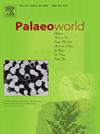Palaeoenvironmental implications of Baiera hallei Sze from the Middle Jurassic in Shaanxi Province, China
IF 1.7
3区 地球科学
Q2 PALEONTOLOGY
引用次数: 0
Abstract
Terrestrial plants are important indicators of palaeoclimate and palaeoenvironment during the geological history. The Ginkgoales leaves are commonly used to reconstruct the atmospheric palaeo-CO2 concentration (pCO2) during the Jurassic. Baiera, a genus of Ginkgoales, however, has been less reported in the reconstruction of the pCO2 during the Middle Jurassic. In this paper, Baiera hallei Sze from the lower Middle Jurassic (Aalenian) Yan’an Formation in the central Ordos Basin is studied in detail based on abundant materials. Ten well-preserved leaves of B. hallei were selected to calculate stomatal parameters, and their stomatal index was used to estimate the pCO2. The average SI was 6.19 ± 0.38, the pCO2 obtained by the stomatal ratio method was 1121 ± 73 ppm, and the average palaeotemperature reconstructed by McElwain’s empirical formula was 13–15.8°C. The pCO2 roughly coincides with the long-term carbon cycle model GEOCARB II. The palaeoclimate in Yulin district was warm and humid during the Aalenian (early Middle Jurassic).
陕西中侏罗统拜拉哈勒斯古环境意义
陆生植物是地质历史上古气候和古环境的重要指示物。银杏叶通常用于重建侏罗纪时期的大气古co2浓度(pCO2)。然而,在中侏罗世的pCO2重建中,银杏属Baiera的报道较少。本文在大量资料的基础上,对鄂尔多斯盆地中部中侏罗统(阿勒统)延安组下侏罗统巴耶拉哈勒斯进行了详细的研究。选取10片保存较好的哈莱叶片计算气孔参数,并利用气孔指数估算pCO2。平均SI为6.19±0.38,气孔比法得到的pCO2为1121±73 ppm, McElwain经验公式重建的平均古温度值为13 ~ 15.8℃。二氧化碳分压与长期碳循环模型GEOCARB II大致一致。榆林地区在阿勒世(早中侏罗世)的古气候是温暖湿润的。
本文章由计算机程序翻译,如有差异,请以英文原文为准。
求助全文
约1分钟内获得全文
求助全文
来源期刊

Palaeoworld
PALEONTOLOGY-
CiteScore
4.00
自引率
5.90%
发文量
95
期刊介绍:
Palaeoworld is a peer-reviewed quarterly journal dedicated to the study of past life and its environment. We encourage submission of original manuscripts on all aspects of palaeontology and stratigraphy, comparisons of regional and global data in time and space, and results generated by interdisciplinary investigations in related fields. Some issues will be devoted entirely to a special theme whereas others will be composed of contributed articles. Palaeoworld is dedicated to serving a broad spectrum of geoscientists and palaeobiologists as well as serving as a resource for students in fields as diverse as palaeobiology, evolutionary biology, taxonomy and phylogeny, geobiology, historical geology, and palaeoenvironment.
Palaeoworld publishes original articles in the following areas:
•Phylogeny and taxonomic studies of all fossil groups
•Biostratigraphy, chemostratigraphy, chronostratigraphy
•Palaeoecology, palaeoenvironment and global changes throughout Earth history
•Tempo and mode of biological evolution
•Biological events in Earth history (e.g., extinctions, radiations)
•Ecosystem evolution
•Geobiology and molecular palaeobiology
•Palaeontological and stratigraphic methods
•Interdisciplinary studies focusing on fossils and strata
 求助内容:
求助内容: 应助结果提醒方式:
应助结果提醒方式:


